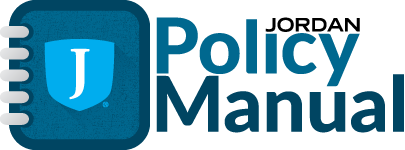- Effective: 8/27/1969
- Revision: 9/8/2009
This policy manual contains approved statements of policy for Jordan School District. The purpose of these statements is to promote a broad and uniform understanding of the manner in which individual members of the District are to operate in a collective effort to achieve District objectives.
Definition of Policy
The term "policy" is subject to widely divergent usage and definition. To insure consistency of interpretation, the following definition has been adopted:
A policy is a statement of the Board of Education's or Administration's intent with respect to matters of broad and long-range significance to the District.
Policies exist at many levels of an organization: Board of Education, District Administration, or school. Within this manual, policies shall be stated at the level of the Board of Education and at the level of the District Administration. In all cases, policies of the District Administration are derived from those of the Board of Education.
By expressing intent, policies specify the direction or delineate the scope of organizational action. Policies automatically result in limits on action. Therefore, to avoid unnecessary rigidity, policies are stated in general and long-lasting terms. Details are avoided wherever possible. With the exception of statutory requirements or instances where specific application of a policy is essential to the long-term welfare of the District, policies allow for flexibility and change.
The policies of the Board apply throughout the District. The subjects that they cover are of Districtwide importance and are intended to remain of such importance into the foreseeable future.
Purpose of Policies
Policies provide administrators and managers with guides to action that have been objectively considered in anticipation of problems. Because they are developed at the level of the Board, the guides are internally consistent; decisions can be made in one area with reasonable assurance that they will be consistent with decisions made in other areas. Being long-range in scope, policies have a stability that tends to insure that today's decisions will be compatible with those made yesterday or those that will be made tomorrow.
Policies imply limits. In striving for a fully coordinated effort, some restraints must be accepted. However, in the very process of establishing limits, policies provide for freedom of action by establishing standards of acceptable action. An individual can act with confidence and dispatch because he/she knows the Board's and the Administration's intentions and desires.
Policies establish the manner in which the District will conduct its relationships with others, such as employees, students, parents, patrons, and vendors. Thus, policies promote good human relations and an attitude of fair and consistent treatment by keeping people informed and minimizing doubt.
Policies, Objectives and Other Guides
Policies and objectives are closely related. "Objectives" are end results, goals, or targets set by the Board or the District Administration. Policies guide and limit the actions and decisions of people as they work toward achieving District objectives. The objectives of the District are included in this manual.
Policies are not the only guides for operations. Specific practices, procedures, and regulations also help govern actions and decisions. These must be consistent with, but not mistaken for, policies.
A "practice" is a means or method of doing something. Practices are the repetitive, continuing actions of the organization; the normal or currently specified ways in which various aspects of the District's activities are conducted. Because policies establish standards of acceptable action, they serve to limit the practices that may be adopted within the District.
“Procedures” are a series of interrelated steps carried out in performing an activity. Procedures define how practices and other activities with the District are performed.
“Guidelines” are specific directions people are expected to obey. They are generally inflexible and often narrow in scope.
A change in policy occurs infrequently, for it reflects a shift in basic intention. However, as changes occur in the environment, both internally and externally, specific practices, procedures, and guidelines must be adapted to meet them. Because of the expectation that changes in specific behavior will be required with relative frequency, procedures and guidelines are published in separate individual manuals to be used within specific departments.
When necessary, the Board of Education delegates to the Superintendent or his/her designee, the authority to make minor edits to policies which do not change the intent or objective of the policy.
The definition of authority relationships, responsibilities, and division of effort are outlined within this manual.
Responsibilities
Accountability for the effectiveness of the District rests ultimately with the Board of Education. Consequently, the determination of policy is the responsibility as well as the prerogative of the Board. The Board acknowledges its responsibility to provide leadership in the achievement of District objectives. This manual provides one aid in discharging that responsibility.
Each administrator and manager shall be responsible for familiarizing himself/herself with all District policies and for communicating them to his/her subordinates. This policy manual is available to all administrators, employees and patrons on the District Policy Manual website.
It shall be the duty of all District personnel to apply District policies judiciously to actions and decisions. Only by translating policy into intelligent action can the integration of effort necessary to attain District objectives be achieved.
Provision for Exception
It is possible that unusual cases may occur in which the best course of action differs from the actions that would be taken in accordance with expressed policy. This does not mean that an otherwise sound policy must be distorted to accommodate the exceptional case; nor would the value of the policies be undermined by ignoring the exception. In such cases the problem would be examined on its own merits and an exceptional decision made where unusual circumstances prevail. However, full awareness of the exceptional nature of the decision and of the serious ramifications of the actions must be carefully considered.
Because policies are officially interpreted by the Superintendent, any exception to an existing policy should have his/her authorization.
